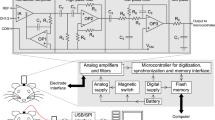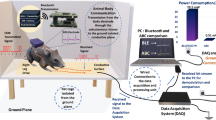Abstract
This chapter presents a standalone wireless Animal-body Tracking and Radiotelemetry (ATR) system, designed and implemented to passively monitor (i.e., sense and estimate) animal’s behavior (location and posture), collect, and transmit physiological data continuously. The proposed system provides a Bluetooth Low Energy (BLE)-based radiotelemetry platform to exchange data with any implants or devices attached to the small animal’s body under test. Monitoring freely moving animals (i.e., rats and mice) in their home cages, 24/7, enables researchers to collect a comprehensive set of data associated with animals’ individual and social activities, behaviors, and physiological parameters. To study epileptic disorders, various physiological aspects are needed to be measured, such as activities (location and posture of the body), electroencephalogram (EEG), electrocardiogram (ECG), electromyogram (EMG), blood pressure, or body core temperature. In epilepsy research, it is desired to run experiments for several weeks, months, or the entire animal life, uninterruptedly, to provide an informative set of information to scientists. The ATR system relies on the multi-resonance inductive link (resonator array) to detect small animals’ location and posture in standard cages, which can be replaced with conventional camera-based technologies. The camera-based systems capture the image information, while the proposed ATR device captures the resonator array’s frequency response, which corresponds to the animal body info. (i.e., location). The resonators of the sensor array generate multiple bifurcations, and any shifts or changes in the quality factors of one or multiple resonance frequencies can be interpreted as changes in the location and posture of the animal.
Similar content being viewed by others
References
Aaron F et al (2007) Pattern recognition of sleep in rodents using piezoelectric signals generated by gross body movements. IEEE Trans Biomed Eng 54(2):225–233
Abdollah M (2019) Multi-resonance- and transfer-learning-based small animal body tracking/sensing system using inductive resonator array. Submitted US Patent application to the HIIE office, UAB
Andreas L et al (2016) EEG radiotelemetry in small laboratory rodents: a powerful state-of-the art approach in neuropsychiatric, neurodegenerative, and epilepsy research. Neural Plast 2016:8213878. Hindawi Publishing Corporation
Andreas G et al (2017) A simplified microwave-based motion detector for home cage activity monitoring in mice. J Biol Eng 11:#36
Andrew Z et al (2015) Long-term continuous EEG monitoring in small rodent models of human disease using the epoch wireless transmitter system. JoVE 101:e52554
Bains RS et al (2018) Assessing mouse behaviour throughout the light/dark cycle using automated in-cage analysis tools. In: Measuring behaviour. J Neurosci Methods 300:37–47
Chiel P et al (2018) A noninterfering system to measure in-cage spontaneous physical activity in mice. J Appl Physiol 125(2):263–270
Claire R (2015) The power of automated behavioural homecage technologies in characterizing disease progression in laboratory mice: a review. Appl Anim Behav Sci 163:19–27
Edoardo B et al (2018) An approach to monitoring home-cage behavior in mice that facilitates data sharing. Nat Protoc 13:1331
Jan G et al (2018) A companion to the preclinical common data elements for physiologic data in rodent epilepsy models. A report of the TASK3 Physiology Working Group of the ILAE/AES Joint Translational Task Force. Epilepsia Open 3(s1):69–89
Joao P, Silva M (2012) Automatic behavior recognition in laboratory animals using Kinect. MS. thesis, Bioengineering, Faculdade de Engenharia da Universidade do Porto, FEUP
Lan J et al (2013) Frequency splitting analysis of wireless power transfer system based on T-type transformer model. Elektronika IR Elektrotechnika 19(10):109–113. ISSN 1392-1215
Laurence B et al (2017) Compass: continuous open mouse phenotyping of activity and sleep status [version 2; referees: 4 approved]. Wellcome Open Res 1(2):1–17
Lucas N et al (2001) EthoVision: a versatile video tracking system for automation of behavioral experiments. Behav Res Methods Instrum Comput 33(3):398–414
Maarten L et al (2014) Sheltering behavior and locomotor activity in 11 genetically diverse common inbred mouse strains using home-cage monitoring. PLoS One 9(9):1–9
Tai OY et al (2011) An infrared range camera-based approach for three-dimensional locomotion tracking and pose reconstruction in a rodent. J Neurosci Methods 201(1):16–123
Tecniplast SpA (2018). http://www.tecniplast.it/en/product/about-dvc.html. Tecniplast DVC
Weizhe H et al (2015) Automated measurement of mouse social behaviors using depth sensing, video tracking, and machine learning. PNAS 112(38):E5351–E5360
Young K et al (2016) Selective wireless power transfer for smart power distribution in a miniature-sized multiple-receiver system. IEEE Tran Indus Elec 63(3):1853–1862
Zheyuan W et al (2018) An automated behavior analysis system for freely moving rodents using depth image. Med Biol Eng Comput 56:1807–1821. Springer
Author information
Authors and Affiliations
Corresponding author
Editor information
Editors and Affiliations
Rights and permissions
Copyright information
© 2022 Springer Science+Business Media, LLC, part of Springer Nature
About this entry
Cite this entry
Mirbozorgi, S.A. (2022). Radiotelemetry for Epileptiform Activity in Freely Moving Rats. In: Sawan, M. (eds) Handbook of Biochips. Springer, New York, NY. https://doi.org/10.1007/978-1-4614-3447-4_63
Download citation
DOI: https://doi.org/10.1007/978-1-4614-3447-4_63
Published:
Publisher Name: Springer, New York, NY
Print ISBN: 978-1-4419-9318-2
Online ISBN: 978-1-4614-3447-4
eBook Packages: EngineeringReference Module Computer Science and Engineering




